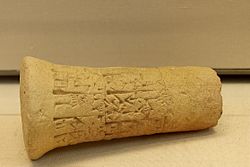Bad-tibira
Itsura
Bad-tibira | |
|---|---|
pamayanang pantao, archaeological site | |
 | |
 | |
| Mga koordinado: 31°22′58″N 46°00′16″E / 31.382777777778°N 46.004444444444°E | |
| Bansa | |
| Lokasyon | Ash Shatrah, Dhi Qar Governorate, Iraq |
Ang Bad-tibira, "Pader ng mga Manggagawa ng Kobre",[1] o "Muog ng mga Panday",[2] na modernong Tell al-Madineh sa pagitan ng Ash Shatrah at Tell as-Senkereh (sinaunang Larsa) sa katimugang Iraq,[3] ay isang sinaunang siyudad ng Sumerya na lumitaw sa mga siyudad na antidelubyano sa talaan ng haring Sumeryo. Ang pangalang Akkadian nito ay Dûr-gurgurri.[4] Ito ay tinawag ring Παντιβίβλος (Pantibiblos) ng mga manunulat na Griyego gaya nina Abydenus, Apollodorus of Athens at Berossus.
Mga sanggunian
[baguhin | baguhin ang wikitext]- ↑ W.F. Albright and T.O. Lambdin, "The Evidence of Language", in The Cambridge Ancient History I, part 1 (Cambridge University Press), 1971, ISBN 0-521-07051-1: 150.
- ↑ Hallo, William W. and William Kelly Simpson, The Ancient Near East: A History, Harcourt Brace Jovanovich, Inc., New York, 1971, p. 32
- ↑ Vaughn E. Crawford, "The Location of Bad-Tibira", Iraq 22 "Ur in Retrospect. In Memory of Sir C. Leonard Woolley" (Spring - Autumn 1960:197-199); the secure identification is based on the recovery at the pillaged site of fragments of a known inscription of Entemena that had surfaced in the black market without provenance. Earlier excavations at a mound called Medain near the site of Lagash, following a report of a vendor of one of the inscriptions, had proved fruitless: see H. de Genouillac, Fouilles de Telloh, ii:139 (noted by Crawford 1960:197 note 7).
- ↑ Collection of taxes from Dûr-gurgurri features in correspondence of Hammurabi (first half of the 18th century BCE) noted in L. W. King and H. R. Hall, Egypt and Western Asia in the Light of Recent Discoveries (New York, 2005) p. 306f; it remained a city of metal-workers and the principal settlement of the guild of gugurrē, "metalworkers" (L. W. King, The Letters And Inscriptions Of Hammurabi, King Of Babylon About B.C. 2200 vol. III, p. 21, note 2.).
